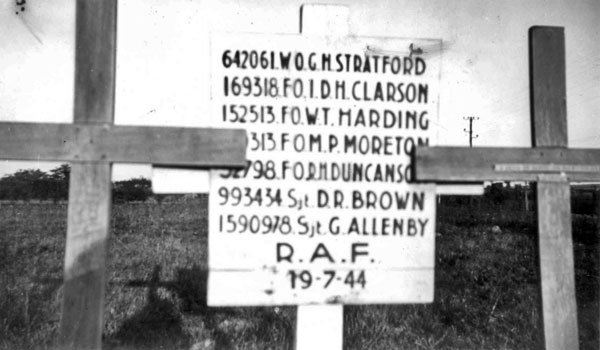During the morning of 7th June 1944 the crew of this 1652 Heavy Conversion Unit aircraft took off from Marston Moor airfield at 10.45hrs to undertake a fighter affiliation exercise. The events leading up to the accident occurring are not yet known other than around ninety minutes after taking off the aircraft was making a landing (possibly at Dishforth airfield) when the pilot was forced to overshoot the landing. Immediately after overshooting and while the aircraft was only a hundred feet off the ground the starboard outer engine failed and immediately caught fire. There was no time to feather the damaged engine before the starboard wing dropped, control was lost and the aircraft then lost height and crashed on land between Ripon and North Stainley at 12.20hrs. The location is given on the accident report, A.M.Form 1180, via a map reference and this plots to being on land near the River Ure, in Ripon Parks, on the opposite side of the river to Norton Conyers Hall. The location is nearly in a direct line with the east-west runway at Dishforth hence my assumption that the landing was to have been at Dishforth as Dishforth is by far the nearest airfield to the crash site. The land near the River Ure was used by the Army during the war and the site may have been on land used by them at the time. Unfortunately several members of the crew were injured and one of the air gunners died in York Military Hospital at 19.20hrs on 7th June 1944 while undergoing treatment there.
The accident report (A.M.Form 1180) gives a map reference for the crash site but not a location. This map reference appears to have been mis-read in other accounts of this incident as one of the digits is unclear. The aircraft is listed elsewhere as crashing between the villages of Mickley and West Tanfield, a few miles north-west but I believe that this is not correct. Research locally by Austin Ruddy has confirmed nothing crashed on land where the incorrectly read map reference could be interpreted as being. In addition it's not recorded by the North Riding of Yorkshire police so it's unlikely to have been on the West Tanfield side of the river.
Halifax DT554 was built to contract B.982938/39 by English Electric Co.Ltd. at Samlesbury and was awaiting collection on 10th October 1942. It was immediately taken on charge by 78 Squadron at Linton on Ouse. On 5th December 1942 it was transferred to 76 Squadron at Linton on Ouse. On 12th December 1942 the port outer propeller struck a contractor's vehicle while taxying at Linton on Ouse sustaining Cat.A/FA damage which was repaired on site. It sustained Cat.Ac/FB damage on 4th February 1943 at Linton on Ouse and was repaired on site. On 20th July 1943 it was transferred to 1652 Heavy Conversion Unit at Marston Moor. On 7th June 1944 it crashed near Ripon on a training flight, Cat.E2/FA damage was the assessment and it was written off.
Air Gunner – Sgt Joseph McGoldrick RAF (638160), aged 22, of Tantobie. Died of injuries. Buried Byer Moor R.C.Cemetery, Durham.
Pilot - F/O Walter Harry Dixon RAFVR (146078). Injured.
Flight Engineer - Sgt J R Dodsworth RAF. Injured.
Air Gunner – Sgt David Robert Brown RAFVR (993434).
Bomb Aimer - F/O Walter Thomas Harding RAFVR (152513).
Navigator – P/O Ian David Henry Clarson RAFVR (169318).
Wireless Operator / Air Gunner – P/O Michael Patrick Moreton RAFVR (169313).

Of those involved in this incident Brown, Harding, Clarson and Moreton re-crewed were posted to 78 Squadron possibly via 1652 H.C.U. They were killed on 19th July 1944 flying Halifax NA513 while bombing a V1 flying bomb site at Acquet, France. They were buried at Neufmoulin Cemetery. I thank the pilot's son, Mr George Stratford, for contacting me and kindly supplying this photograph of their original grave marker.
Walter Harding received a commission to P/O on probation (emergency) on 25th June 1943 and rose to F/O (war subs)on 25th December 1943.
Ian Clarson was the son of Major Joseph Henry Plant Clarson (formerly 3rd Bn.The Cameronians (Scottish Rifles)), and Winifred Alice Clarson (nee Gradidge). Walter received a commission on 1st February 1944 to P/O on probation (emergency). He is commemorated on Long Sutton War memorial in Hampshire.
Michael Moreton was the son of Sidney Thomas and Eileen Moreton, of Ealing, Middlesex. He received a commission on 11th December 1943 to the rank of P/O on probation (emergency) and rose to F/O (war subs) on 11th June 1944.
David Brown RAFVR was the son of James and Elizabeth Brown, of Ashington, Northumberland but was born in Morpeth area.
Walter Dixon was born on 14th January 1916, probably in the Hull area (a birth of W.H.Dixon registered in Sculcoates in 1916 would fit). As a young man he joined Hull City Police force on 31st October 1938 but left to join RAF on 6th October 1941. He received a commission to the rank of P/O on probation (emergency) on 26th June 1943, rising to F/O on probation (war substantive) on 26th December 1943 and to F/Lt (war substantive) on 26th June 1945. On 21st October 1945 he relinquished his commission on the ground of medical unfitness for Air Force service, retaining the rank of F/Lt. Having left RAF he re-joined the police (probably in Hull) in November 1945. A Walter Harry Dixon died in Beverley, Yorkshire in 1992 to which I assume he is the same person.
I credit Austin Ruddy with help in creating this webpage.